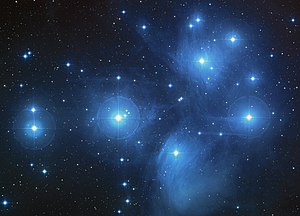Know in Depth
In this section you will be able to learn a little more in depth about the objects that we will see in the astronomical observation of the month. Choose the astronomical object you want:
Nebulosa Esquimal

The Eskimo Nebula ( NGC 2392 ), also known as the Clown-faced Nebula, Lion Nebula or Caldwell 39 , is a bipolar double-hull planetary nebula (PN). It was discovered by the astronomer William Herschel in 1787. The formation resembles a person’s head surrounded by a bonded parka . It is surrounded by gas that made up the outer layers of a sun-like star. The visible inner filaments are blown away by a strong wind of particles from the central star. The outer disk contains unusual light-year filaments.
This nebula is located about 6500 light years away and is visible with a small telescope in the constellation Gemini .
Nebulosa Variable de Hubble

NGC 2261 (also known as the Hubble Variable Nebula or Caldwell 46 ) is a variable nebula located in the constellation Unicorn. It is illuminated by the star R Monocerotis , in this same constellation, although the star itself is not directly visible .
For amateur astronomers, the nebula NGC 2261 is an interesting object due to its variability . One of the proposed explanations for this variability is that dense dust clouds near R Mon periodically block the star’s illumination.
Cúmulo Abierto

An open cluster is a type of star cluster made up of a few thousand stars that formed from the same giant molecular cloud and are roughly the same age. More than 1,100 open clusters have been discovered within the Milky Way, and many more are believed to exist.
[1] They are loosely held together by mutual gravitational attraction and are interrupted by close encounters with other gas clusters and clouds as they orbit the galactic center. This can result in a migration to the main body of the galaxy and the loss of members of the cluster through close internal encounters.
[2] Open clusters generally survive a few hundred million years, with the most massive ones surviving a few billion years. In contrast, more massive globular star clusters exert a stronger gravitational pull on their members and can survive longer. Open clusters have been found only in spiral and irregular galaxies, in which active star formation is taking place. [3]
Cúmulo Globular

A globular cluster is a spherical set of stars that, generally, orbits a galactic nucleus as if it were a satellite. These owe their shape and their union to the gravitational force .
Globular clusters are found in the area of the galactic halo of a galaxy and contain considerably more stars and are much older than open clusters . Globular clusters are quite common; there are about 150 to 158 Globular clusters currently known in the Milky Way, and perhaps 10 to 20 more, yet to be discovered because they are located behind the center obscured by the thousands of stars in the nucleus and interstellar dust.
Globular clusters orbit our galaxy at typical distances of 130,000 light years or more.
Cúmulo Abierto con Nebulosa

NGC 2360 (also known as Caroline’s Cluster [3] or Caldwell 58) is an open cluster in the constellation Canis Major. It was discovered on February 26, 1783 [4] by Caroline Herschel, who described it as a “beautiful, highly compressed star cluster about 1/2 degree in diameter.”

